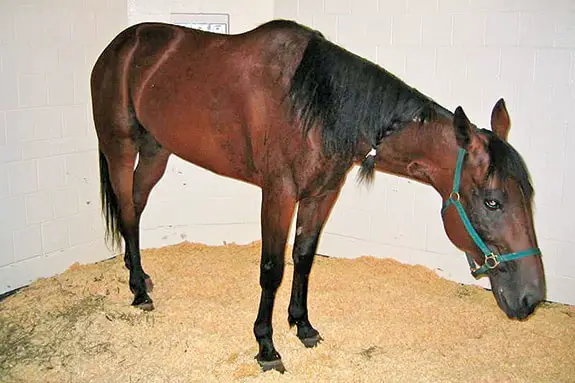Potomac Horse Fever (PHF) is an equine disease that occurs only in the summer and autumn and is most common inland near rivers. The disease also called Equine Monocytic Ehrlichiosis or Shasta River Crud. The disease accounts for outbreaks of diarrheal illness in equine that are kept near streams, rivers, or irrigated pastures. The arthropod vector has not yet been identified, but there is some evidence that mice are the organism’s reservoir. This disease should be identified by a differential diagnosis in acute toxic colitis in an area enzootic for Ehrlichia risticii.
Causes of Potomac Horse Fever
The bacteria responsible for the disease, Ehrlichia risticii or Neoricketcia risticii is a rickettsial organism responsible for acute enteric type colitis, which emerged as a pathogen of American Horses about 15 years ago, is related antigenically to E canis but not E equi. E risticii is a morphologically typical rickettsia and grows well in cultures of macrophages.

Transmission and Pathogenesis of Potomac Horse Fever
Serological evidence indicates that infection with E risticii is widespread in the USA. Still, the disease itself only occurs sporadically and is often confined to an individual animal in a group. Younger animals appear to be less susceptible.

The disease is transmissible by transferring infective blood to susceptible animals, including the intradermal route, so the possibility of iatrogenic infection needs to be kept in mind. The disease is infectious but not transmitted to other animals through direct contact. An attack induces high levels of immunity, and recovered cases are apparently immune to further clinical episodes and probably even infection.
How do you know about the Potomac Horse Fever?
The end of the disease onset period of 9-15 days is marked by depression, anorexia, and fever. A profuse or even projectile diarrhea follows quickly in about half of the cases, in other affected animals, the diarrhea is milder. Colic, anasarca, and laminitis also occur in about a third of the cases. The onset of laminitis is regarded as expressing a poor prognosis. As the clinical signs progress, the severest cases go into deep hypovolemic shock.

The clinical severity of PHF is variable, but the case fatality rate is approximately 30% in untreated animals. Recovered horses may remain infectious for up to 8 months after the resolution of the clinical signs. At the onset of the disease, a marked decreased leukocytes in the blood is succeeded by a leukocytosis, and the increasing PCV and plasma protein concentrations are a reflection of the severity of diarrhea.
The severity of diarrhea reflects the extent of the erosive or ulcerative lesions seen principally in the caecum and colon but found the whole of the gut. Aortic, cardiac, and liver hemorrhages may be present. Inflammation of blood vessels and thrombus formation may be seen microscopically.
How Do You Diagnose the Disease?
Clinically the disease is challenging to distinguish from an acute attack of salmonellosis or colitis X. However, clinical signs in the confirmed absence of other pathogens and the clinicopathological changes ( leukocytosis, increased PVC, plasma protein) may assist in diagnosis. E risticii is rarely seen in monocytes in suitably stained blood smears, and isolation of the organism in the laboratory is difficult.

The serological examination of paired blood samples collected at appropriate intervals assists in diagnosis. Immunofluorescence assays can determine a rise in antibody titer against E risticii. The test of a single sample is of doubtful value. The antibody response induced by infection with E risticii appears early in the course of clinical disease and persists for at least a year.
How Do You Treat and Prevent Potomac Horse Fever?
As with other rickettsial diseases, the tetracyclines are devoured for therapy. No instance of resistance of E risticii to tetracyclines appears to have been recorded. Non-specific, supportive therapy, especially to correct the dehydration induced by diarrhea, is also mandatory in severe cases. The prospects for satisfactory vaccination of horses in affected areas are excellent. Killed bacteria are useful experimentally in protecting against challenge.

Is Potomac Horse Fever Contagious or Zoonotic?
Potomac Horse Fever or Equine Monocytic Ehrlichiosis is not a contagious disease. At the same location, you keep more than one horse; it spread the disease due to the environmental condition. The disease causes the inflammation of colon, diarrhea, and dehydration. Potomac horse Fever is not a Zoonotic disease. There is no known zoonotic risk.
Prognosis of Equine Monocytic Ehrlichiosis
The prognosis varies from good to grave, depending upon the severity of clinical signs and laboratory changes. In general, horses that remain alert with an appetite and those treated with oxytetracycline before the onset of diarrhea have a reasonably good prognosis. The occurrence of renal azotemia, laminitis, and abdominal distension with the cessation of diarrhea worsens the prognosis.
Final Advice on Potomac Horse Fever
Potomac horse fever or Shasta River Crud is a fatal febrile disease of horses. The disease is fatal, and your horse may die if you could not diagnose and treat at the proper time. If you can give proper treatment and care at the earliest time, you can save your horse. The disease is not contagious and has no zoonotic significance. You do not have any risk of getting the disease from your horse. The information I have provided in the article will help you to know better about your horse.
